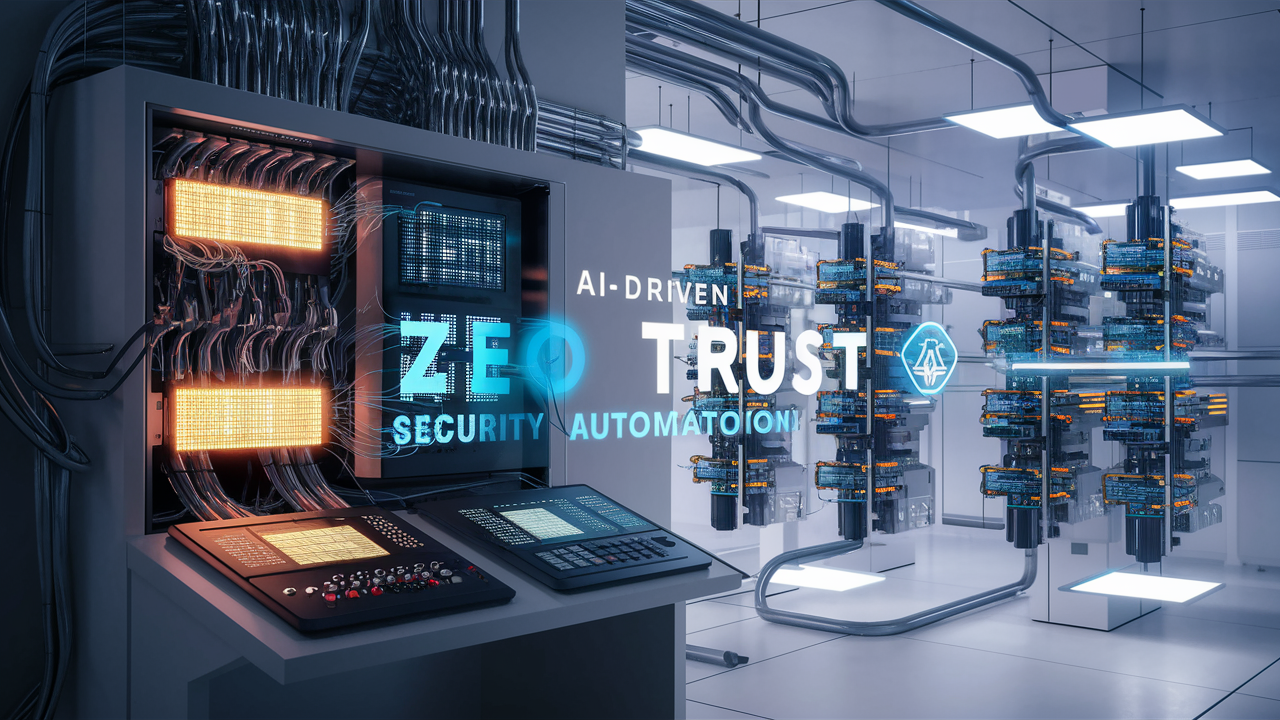The Future of Zero Trust with AI: Exploring How AI Automates and Enhances Security
Explore how AI automates Zero Trust security, boosting protection against today's threats. Learn best practices and the future of this powerful combo.

In a world overrun by cyberattacks, where data breaches wreak havoc on businesses and individuals alike, the traditional perimeter-based approach to cybersecurity is failing. Enter Zero Trust, a security model rooted in the mantra "never trust, always verify." Zero Trust promises enhanced protection in today's complex digital landscape, and artificial intelligence (AI) is the catalyst that unlocks its full potential.
In this article, we'll delve into the cutting-edge integration of AI and Zero Trust, exploring how AI empowers this evolving security paradigm to become smarter, more adaptable, and infinitely more effective.
Understanding Zero Trust: What Is It, and Why Is It Vital?
Imagine your network as a fortress. Conventional cybersecurity focuses on building the most robust possible walls. The problem? Once attackers breached the perimeter, they had alarmingly free rein within the network.
Zero Trust flips this model. It assumes no user, device, or application should be trusted by default – whether inside or outside your network. It necessitates continuous verification for every single access request. Essentially, Zero Trust eliminates the concept of an implicit trust zone.
Core Tenets of Zero Trust
- Microsegmentation: Networks are divided into granular zones to limit attackers' lateral movement should they gain any access.
- Least-privilege Access: Users and devices are granted only the minimum necessary permissions to perform their functions.
- Continuous Monitoring and Verification: User behavior, device posture, and network activity are relentlessly scrutinized to detect anomalies.
- Multi-Factor Authentication (MFA): Passwords alone aren't enough; MFA adds layers of identity verification for enhanced security.
The Limitations of Traditional Zero Trust
While robust, Zero Trust isn't without flaws. Here's where AI makes a transformative difference:
- Rule Management: Manually creating and maintaining intricate access policies is tedious and prone to error – especially as networks scale.
- Log Analysis: Sifting through mountains of security logs to pinpoint threats is a time-consuming task that humans can't do with optimal speed and accuracy.
- Anomaly Detection: Traditional tools often struggle to detect subtle deviations that may reveal sophisticated attacks.
AI: Supercharging Zero Trust
AI steps in to revolutionize Zero Trust with its capacity for pattern recognition, anomaly detection, and automated decision-making:
- Intelligent Policy Creation: AI analyzes vast user behavior and activity datasets to suggest tailored, granular access policies, reducing administrative overhead and minimizing human error.
- Behavioral Analytics: AI builds robust user and entity profiles, establishing a baseline of 'normal'. Deviations trigger alerts, helping identify compromised accounts and insider threats early.
- Advanced Threat Detection: AI excels at finding hidden patterns within massive volumes of network data, detecting the subtle signs of zero-day attacks or advanced persistent threats (APTs) faster than humanly possible.
- Automated Response: AI-driven Zero Trust can instantly isolate suspicious devices, quarantine compromised accounts, or redirect traffic, mitigating threats at machine speed.
- Adaptive Security: AI learns and evolves in real time, adjusting policies and protections dynamically based on the latest threat intelligence and changing network conditions.
Practical Use Cases of AI in Zero Trust
Let's look at specific real-world applications of AI-powered Zero Trust:
- Risk-Based Authentication: AI calculates dynamic risk scores based on user behavior, device health, geo-location, and more. High-risk scenarios trigger stricter authentication steps.
- Network Traffic Anomaly Detection: AI spots unusual data flows, malicious code patterns, or suspicious communication, potentially signaling an active attack.
- Zero Trust for IoT: AI helps secure the notoriously vulnerable world of IoT devices, profiling their typical behavior and segmenting them for enhanced protection.
- Privileged Access Management (PAM): AI monitors privileged user activity with extra scrutiny, guarding against insider threats or credential abuse.
The Ethical Edge: AI Challenges to Consider
- Bias: AI models can inherit human bias. Careful dataset curation and algorithm design are crucial to avoid unfair discrimination in security decisions.
- Explainability: Understanding AI's decision-making rationale is essential for trust and accountability.
- Adversarial AI: Attackers use AI to craft attacks designed to fool AI-based defenses. Vigilance and continuous security research are vital.
Best Practices for Implementing AI-Enhanced Zero Trust
Embracing AI within your Zero Trust architecture requires a strategic approach:
- Start Small, Iterate: Don't try to revamp everything at once. Before expanding, focus on critical assets, high-risk areas, or a particular use case (e.g., threat detection).
- Data is King: Ensure you collect high-quality, relevant data to feed your AI models. Poor data leads to poor decisions.
- Explainable AI: Prioritize AI solutions that provide insights into their reasoning, facilitating auditing and troubleshooting.
- Human-in-the-Loop: Initially, maintain human oversight and judgment, particularly for actions with significant impact.
- Continuous Learning and Improvement: AI and the threat landscape are ever-evolving. Regularly evaluate your models and retrain them as needed.
The Future: Zero Trust Meets Continuous Adaptation
The future of AI-powered Zero Trust lies in continuous adaptation. Security is not static; as attackers find new techniques, AI must evolve to counter them. We're likely to see advancements in:
- Self-Healing Networks: AI will proactively identify vulnerabilities, patch systems automatically, and adjust real-time security configurations.
- AI-Orchestrated Incident Response: AI will orchestrate the full incident response cycle, automating analysis, containment, and remediation with minimal human intervention.
- Generative AI for Security: We might see generative AI models used to create realistic but synthetic attack simulations, training AI defenses more effectively.
Closing Thoughts
The convergence of Zero Trust and AI is a cybersecurity game-changer. By leveraging AI's cognitive power, organizations can achieve unprecedented levels of protection, moving from reactive to truly proactive security. While challenges and ethical considerations remain, the potential benefits outweigh the risks.
This is a golden opportunity for tech entrepreneurs in the AI and cybersecurity space. Developing innovative solutions that push the boundaries of AI-powered Zero Trust will be instrumental in shaping the future of secure digital ecosystems.

